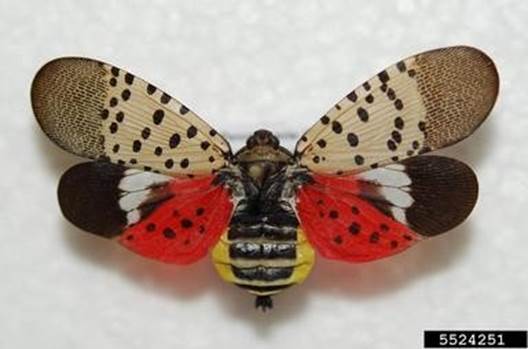AgEBB-MU CAFNR Extension
Green Horizons
Volume 22, Number 2
Spring 2018
Agroforestry
Spotted Lanternfly: Beautiful Bug, Sticky Mess
By Sarah Phipps| Missouri Department of Agriculture
The feeding habits of an invasive bug strikes again! Spots on the front wings and flashes of red on the back wings make this inch-long spotted lanternfly (Lycorma delicatula) a beauty! While this attractive planthopper has a striking appearance, don't admire for too long as it's just a hop, skip, and a jump away from sullying a plant near you. These insects can jump 6 to 9 feet to evade danger. When they land on vehicles, they can hitch a ride to new areas. Movement of this pest can also occur by way of egg cases that they lay on hard surfaces such as tree bark, rail cars, shipping pallets, and many other outdoor items. Egg cases are easily overlooked as a mode of transportation because they look like a smear of mud.
Although native to China, India and Vietnam, the spotted lanternfly has taken a foothold in thirteen Pennysylvania counties since its first detection in 2014 on a shipment of imported stone products. A subsequent detection occurred in Virginia when the lanternfly hitched a ride on stone products. An established population outside Pennsylvania has been found in Frederick County, Virginia.Additional detections have been reported in Delaware, Maryland, New Jersey and New York.
This sap feeding planthopper feeds on over 70 plant species including grapes, fruit trees, various hardwoods (including oak, walnut and maple), hops and row crops. It also has a close association with Ailanthus (Tree of Heaven). As it voraciously feeds in groups, it secretes a sticky, sweet substance calledhoneydew that allows black sooty mold fungi to grow, tarnishing plants and the surrounding environment.
 |
Adult spotted lanternfly. Photo credit Lawrence Barringer, Pennsylvania Department of Agriculture, www.Bugwood.org. |
We'd be much better off if the gummy mess was limited to homeowners having to power wash the stickiness off the back porch! Unfortunately, the real clean up happens when this pest visits commercial ventures like vineyards, fruit growers and other farms. Pennsylvanians, in particular, have experienced the true economic disorder this insect can create.
Spotted lanternflies were first detected in Pennsylvanian vineyards in 2016, with additional vineyard detections in 2017. They create messes wherever they go and are also reducing yields in some vineyards. Vineyards are particularly susceptible to the lanternfly due the direct damage they inflict with their piercing-sucking mouthparts on grapevines, which can make the grapes unsuitable for quality wine production. Unfortunately, the honeydew they leave behind causes mold to grow on the vines and foul the fruit long after they have moved on to the next plant.
The lanternfly's close association with Ailanthus warrants more research. Currently, it is believed that the lanternfly requires Ailanthus to complete its lifecycle. Management efforts include wrapping brown sticky bands around the tree to target and catch nymphs. Removal of female Ailanthus host trees and treating the male Ailanthus trees with systemic insecticide also appears to help significantly reduce the population.
Due to the dramatic expansion of the lanternfly that occurred in Pennsylvania, the USDA provided $17.5 million in emergency funding to help stop the spread of spotted lanternfly throughout Pennsylvania and neighboring states.
While this 'bad bug' has not been found in Missouri yet, early detection is vital. The eggs hatch May - June and are black with white spots during the first 3 nymphal stages. Some observers advise that the nymphs look like small ticks. Adults can be seen as early as mid-July. Keep an eye out for the easily hidden "mud-smeared" egg cases which can be seen from Oct. - June. Anyone who finds asuspected lanternfly is encouraged to capture andpreserve it by putting it into an alcohol-filled vial. If this is not possible, a good picture could help aid us in early detection. Please make reports to the Missouri Department of Agriculture State Entomologist by emailing collin.wamsley@mda.mo.gov or calling 573-751-5505.
More information about the spotted lanternfly can be found at:
www.agriculture.pa.gov/spottedlanternfly
https://extension.psu.edu/spotted-lanternfly-on-grapes- and-tree-fruit
